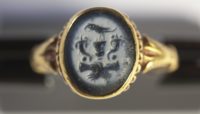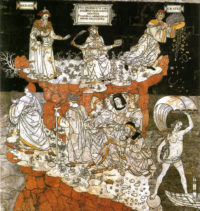More than once over the past few weeks I have thought about the Decameron, the early Italian-language masterpiece written by Giovanni Boccaccio in the mid-14th century as the Black Death ravaged Tuscany, the peninsula, the continent. In it, 10 youths, seven women and three men, flee plague-ridden Florence and hole up in a villa in the countryside for two weeks. To alleviate the boredom of their self-quarantine, they tell each other stories for 10 nights of the 14 (with exceptions for the two Sundays, and one day per week dedicated to chores which is rather impressive roommating considering the circumstances, actually). By the end of their stay, they’ve told 100 stories.
With all of Italy on lockdown, museums and heritage sites closed, people stuck in their abodes for days at a time, the Uffizi Gallery has launched a digital Decameron to entertain and console the shut-in with photographs, videos and stories shared on all its social media platforms — Twitter, YouTube, Facebook and Instagram — under #UffiziDecameron.
The Uffizi picks from the immense wealth of artworks in its Gallery of Statues and Paintings, in the Palazzo Pitti and the Boboli Gardens, posts a photo or clip, and their social media curators explain the background and meaning of each piece. The first video posted was a wordless tour of the Boboli gardens with aerial and terrestrial footage that is just breathtakingly beautiful. The second is a tour by museum assistant Cristina De Caro of the Uffizi’s Contini Bonacossi collection, something I knew not a single thing about before today.
 The portrait by Bronzino of Eleonora di Toledo, wife of Cosimo I de Medici, wearing an exquisitely brocaded gown, her arm draped around the shoulders of their son and heir, is world-famous. Less well-known is the ring Cosimo gave her for their wedding: a Roman intaglio stone with matrimonial motifs (cornucopias, intertwined hands) he had set by Florentine goldsmiths. It is one of very few surviving examples of secular gold work from the early Medici dukes in Florence today because the family treasure was so widely dispersed. The reason it’s in the Uffizi today is that Eleonora was buried with it. It was found when the remains of the 50 Medici family members buried in tombs in the walls of San Lorenzo were moved to the crypt under the church in 1857.
The portrait by Bronzino of Eleonora di Toledo, wife of Cosimo I de Medici, wearing an exquisitely brocaded gown, her arm draped around the shoulders of their son and heir, is world-famous. Less well-known is the ring Cosimo gave her for their wedding: a Roman intaglio stone with matrimonial motifs (cornucopias, intertwined hands) he had set by Florentine goldsmiths. It is one of very few surviving examples of secular gold work from the early Medici dukes in Florence today because the family treasure was so widely dispersed. The reason it’s in the Uffizi today is that Eleonora was buried with it. It was found when the remains of the 50 Medici family members buried in tombs in the walls of San Lorenzo were moved to the crypt under the church in 1857.
 Over on Instagram the quarantine festivities kicked off with a 19th century painting by Vincenzo Cabianca of a scene from the Decameron. More recently they posted a riveting explanation of the complex imagery in a section of the Siena Duomo’s unbelievable inlaid marble mosaic floor designed by Pinturicchio in 1504.
Over on Instagram the quarantine festivities kicked off with a 19th century painting by Vincenzo Cabianca of a scene from the Decameron. More recently they posted a riveting explanation of the complex imagery in a section of the Siena Duomo’s unbelievable inlaid marble mosaic floor designed by Pinturicchio in 1504.
As a companion to the Uffizi Decameron initiative, the museum will also publish images, video and content dedicated to Raphael. It’s the 500th anniversary of his death this year, and the Scuderie del Quirinale museum in Rome was hosting an unprecedented exhibition dedicated to the Renaissance master. My plans to write about the show were derailed by horror, so it warms the cockles of my broken heart that the Uffizi, which loaned 50 of its works out of the 200 or so on display, will be sharing online what cannot be shared in person right now.
“Even if museums have had to close their doors, art doesn’t stop,” explained Uffizi director Eike Schmidt. “This is why from now on we will address our public also through Facebook. The treasures of the Uffizi, Palazzo Pitta and the Boboli Gardens will keep you company in these weeks of the common commitment against the spread of the virus. Today we begin Uffizi Decameron: as in the masterpiece by Boccaccio, every day we will tell stories, the works, the personages of our most beautiful museums, uniting us in the name of culture, of art, and — why not — of amusement. The Uffizi will be with you, in your homes, to overcome all together the current moment of difficulty. We avoid all contagion, except that of beauty.”
So much lump in throat right now. Hai tutto il mio amore, Italia.